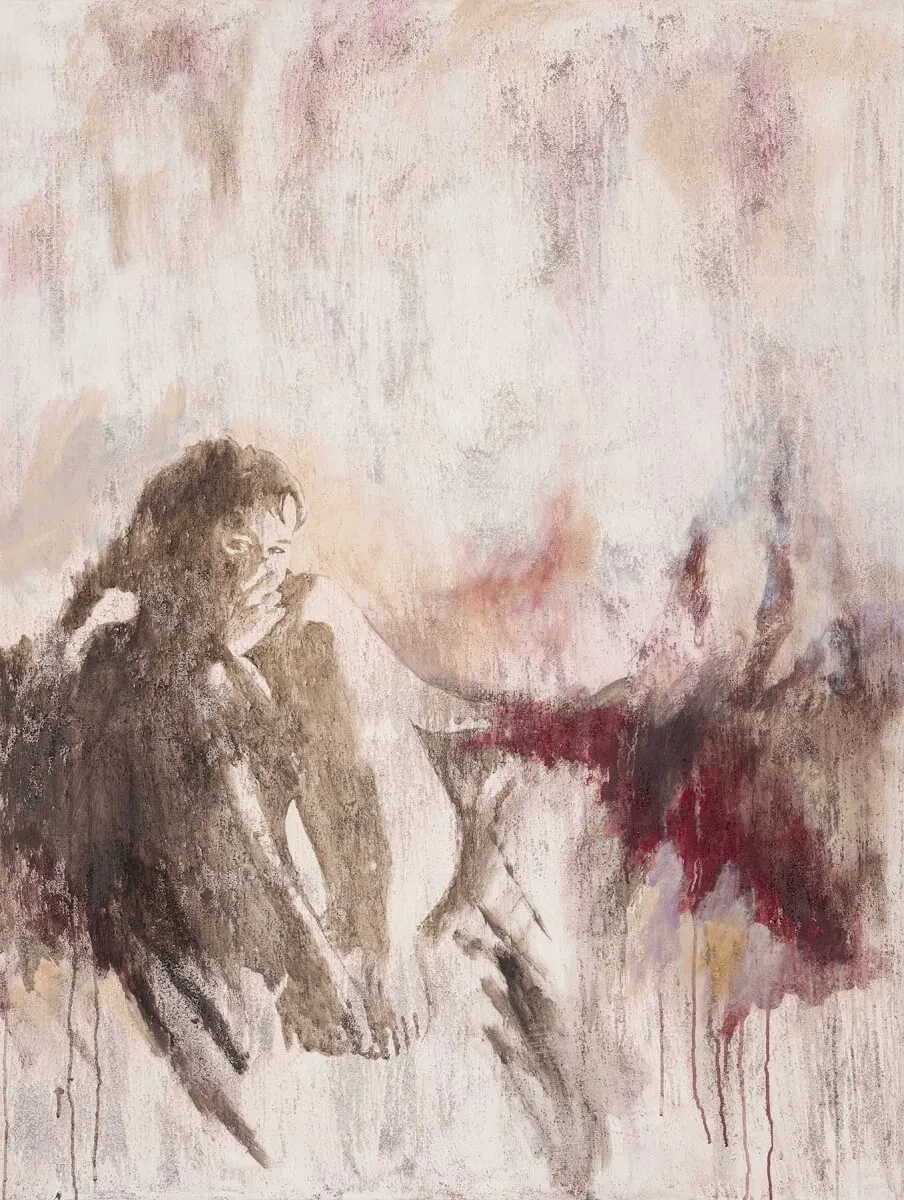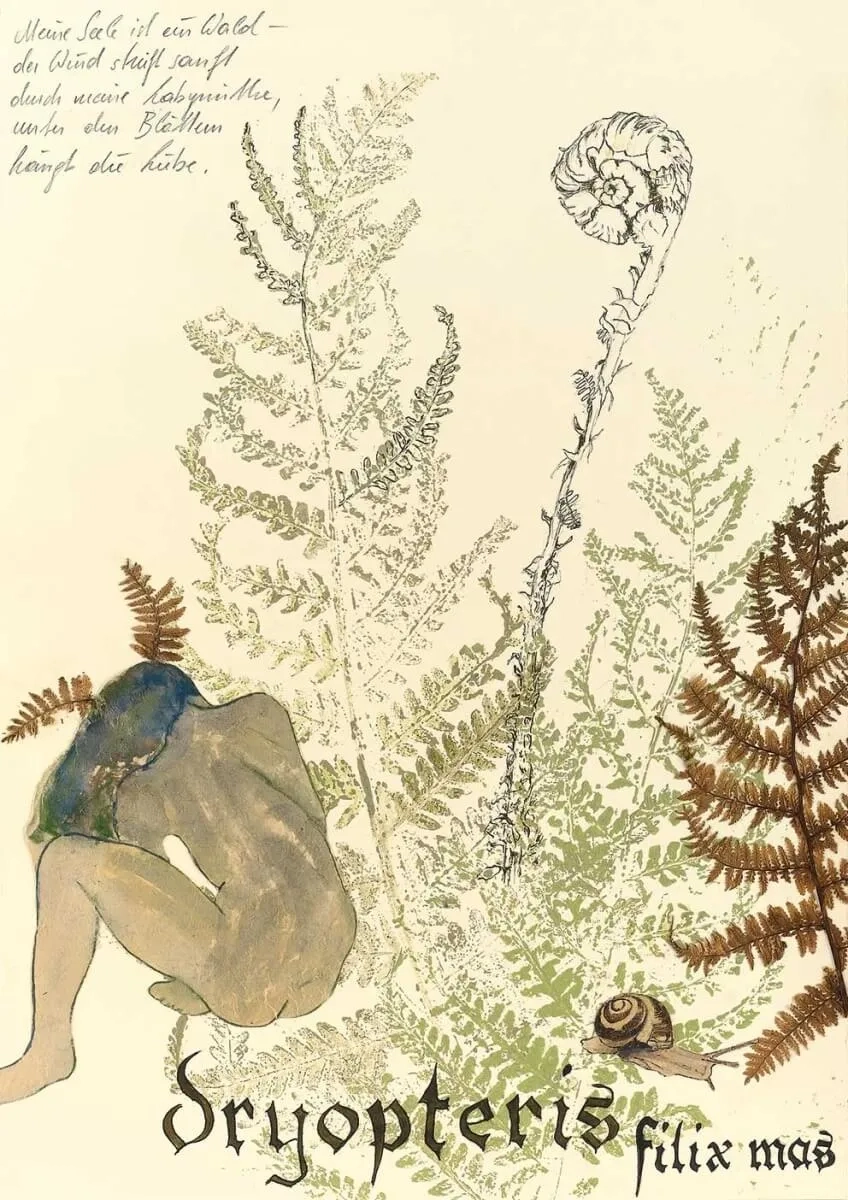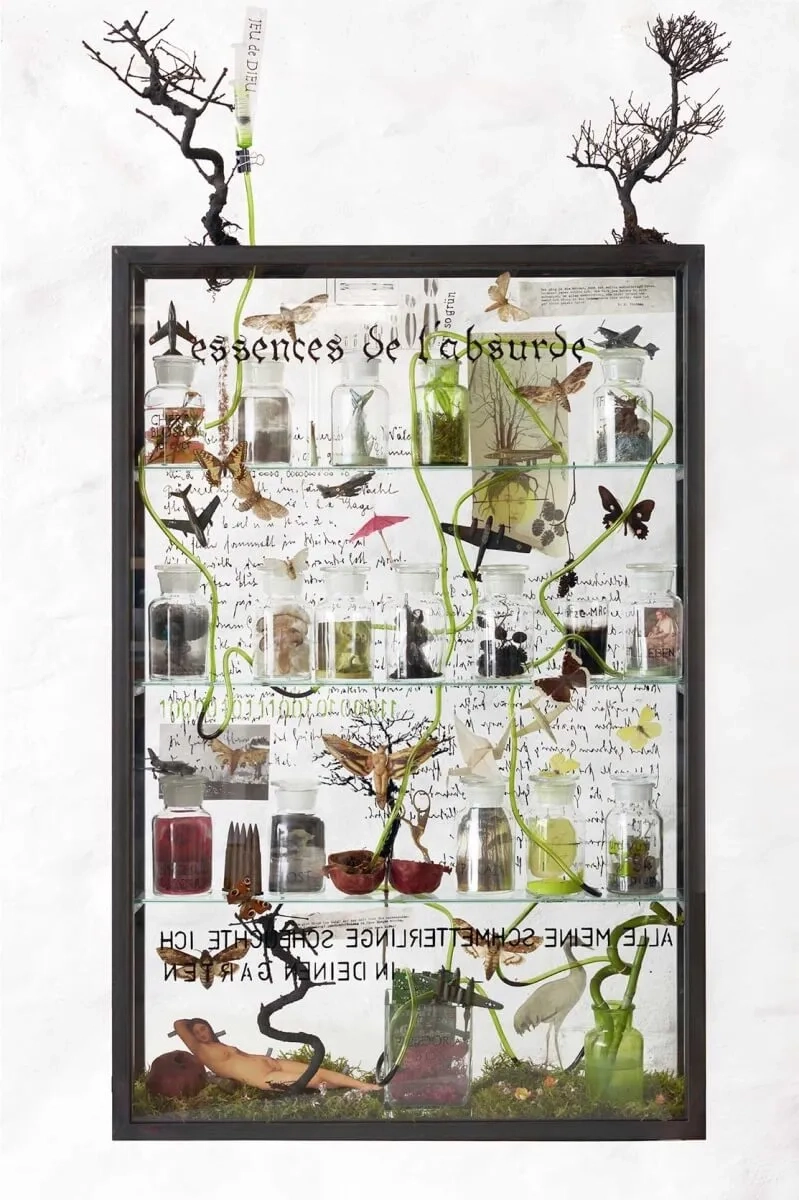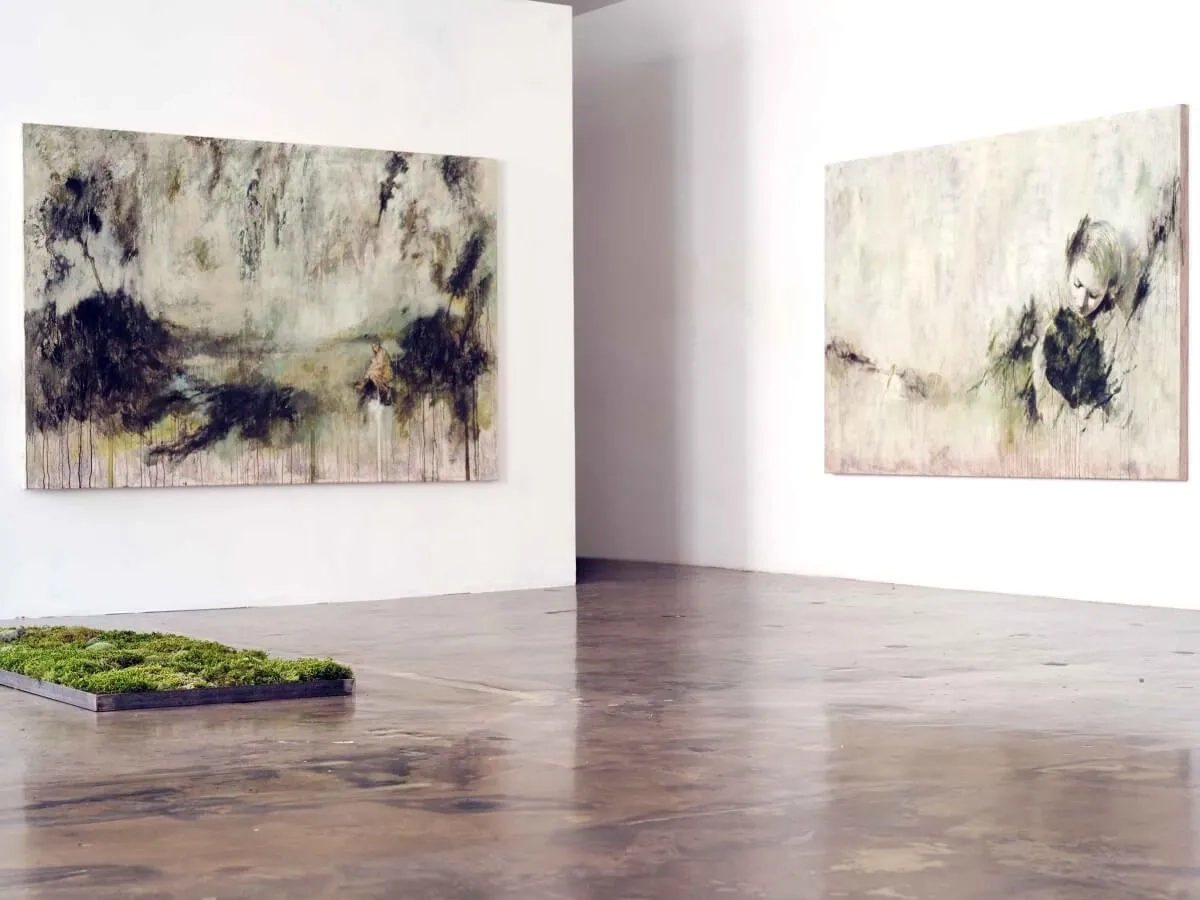In the title of her book, Sonia Gansterer takes the line ‘I dye the heaven blackberry for you’ from the disillusionist poem Abschied by the poet Else Lasker-Schüler from the past into a present that allows for illusion. With her objects, installations and paintings, she creates a soothing antithesis to the zeitgeist. She counters the superficial perceptiveness of a fast-moving consumer society with a rough structure in the priming of the canvas, which demands constant attention and offers resonance in the brushstroke. In their complexity, Sonia Gansterer's works remain a constant challenge to think, feel and love.
Hrsg.: Sonia Gansterer, Clemens Feigel (2020)
Autoren: Clemens Feigel, Wolfgang Giegler, Günther Oberhollenzer
Mit Texten von Blixa Bargeld, Paul Celan, Sonia Gansterer, Franz Kafka, Else Lasker-Schüler, Gerhard Rühm, Henry David Thoreau, Georg Trakl, Christa Wolf
Grafik: Jörg Gaisbauer, Sonia Gansterer
Dt./Engl. Übers.: Otmar Lichtenwörther
Druck: Gerin Druck GmbH Holzhausen
238 Seiten, gebunden, € 38,-
ISBN 978-3-9519795-0-2
My soul is a forest
a retrospective on Sonia Gansterer in book form
In September 2020 the catalogue ›I dye the heaven blackberry for you‹ was presented as part of a very subtle exhibition of Sonia Gansterer’s artwork in the sehsaal in Vienna. Both the exhibition and the catalogue are a respectfully cautious and hearty invitation to get to know, understand, and love the fascinating work of Sonia Gansterer. The catalogue is particular, not only because it is the first publication of the newly founded Edition Eremitage am Kamp. At the book launch, Clemens Feigel explained his personal reasons for founding a publishing house. On the one hand, he wanted to achieve the exactness and the perfection he thinks a book requires. On the other hand, the film ›Fahrenheit 451‹ showed him that although books were repeatedly banned and burned in the past, not all books could be tracked down and because of this, a copy always survives somewhere. Therefore, it is important to give things that are important to oneself durability in book form.
what will last from me
sometime
is the painted moment
This says Sonia Gansterer on behalf of herself. The exhibition in the sehsaal, although open for only a short time, is such a lasting moment. Lasting, lasting in memory – I would like to start with my memories of the exhibition and of what it showed me and made clear to me in Sonia Gansterer’s work and only then will enlarge on the catalogue. Not only were the artworks on display special, but also that, by the interaction of the artwork with the spacious conditions, the exhibition itself was conceived as a work of art. Even the floor was taken into account for the selection of the pictures. Sonia Gansterer incorporates in some of her pictures objects such as postcards, real feathers or plastic flowers, things that do not strike one’s attention immediately but astonish later on. Sonia Gansterer achieves a similar tilting moment in her pictures when nature and humans merge or originate from one another. I stood for a long time in front of a large canvas depicting a tree on which hangs a gown, before I noticed the face of a woman at the top on the left. How could it be that I had overseen it for so long? On another occasion I noticed from the outside, while looking from the evening twilight through the window into the brightly lit showroom, how from this distance one of the trees on a small fraction of one picture suddenly appeared as a human eye. Apart from the pictures there were oblong collages on the floor made out of lichen and moss in wonderful shades of blue-green. And near a window there was a small bird’s nest, seemingly by chance and as if forgotten, woven from small branches with some moss. Overall, the exhibition conveyed the impression to me that Sonia Gansterer creates with her art a realm, a moment or an “in-between-ness”, which acts as a membrane open and permeable in all directions and times. Real objects might walk into the picture and become part of it, dreamlike things from her world of images can easily get lost into our world as the small bird’s nest on the window sill. With such open and fog-like drifting borders between the worlds one cannot help but to take care not to fall into one of the paintings and find oneself being part of the artwork.
›I dye the heaven blackberry for you‹ contains, apart from numerous pictures also detailed views, quotes from Sonia Gansterer and citations that were an inspiration and a catalyst for her work and finally three different essays on the peculiarities of her work, one by Clemens Feigel (›thinking and loving and painting‹), another by Wolfgang Giegler (›exhaust and create‹), and a third by Günther Oberhollenzer (›a strange soul and a woman collecting the world‹). All three know Sonia Gansterer and her oeuvre very well, and give us their own view on it, which is very fascinating, because the essays complement each other, focus on different aspects and take different points of view. As everyone is highlighting different facets, we get a broad and detailed insight into Sonia Gansterer’s work. Common to all three is an amazed and respectful view of it. This triple, very complex and manifold discussion encourages us to seek and finally to find a personal approach to Sonia Gansterer’s oeuvre. All textual contributions, quotes and descriptions are bilingual in German and English and by this the catalogue is opening Sonia Gansterer’s work not only for a German speaking, but also for an international public.

Sonia Gansterer’s art-works are impressive not only because of the colour scheme: she is gladly using intense dark colours as raspberry or black, contrasting them with effacing pastels. This combination symbolizes to me a great courage and a strong artistic self-confidence while maintaining openness, vulnerability and a tremendous sensibility for nuances, details, atmosphere and intermediate tunes. Sonia Gansterer is willingly using coffee brew as a primer layer, because its granular structure results in a rough painting support and the picture gains in expressive power. Lettering is very important in her pictures. Firstly, as a visual part of the image; be it handwritten or stencilled, the lettering is always an integral part of the overall composition. On the other hand, the lettering is not only used because of its visual appearance but is in the first place a carrier of content. By this, we come to another important aspect in Sonia Gansterer’s oeuvre: literature as source of inspiration. Her starting points are often a poem, a verse or a short quotation, which inspire her to a full cycle of works. But even if she uses only a short quotation, the engagement with the respective work of the author is always profound and extensive. She says of her occupation with Trakl:
Approaching Trakl
Reading his texts – time and time again
Reading about his life
Reading his texts – slowly, more and more slowly
Thinking in his images
Starting to paint
[…]
Emulating his handwriting
Welding a pharmacy of iron
Lettering the jars with his words
Putting Trakl’s words, his essences, his poisons into jars
Reading his texts
Approaching Trakl, closer, closer and closer
Authors who inspired and stimulated her apart from Trakl are amongst others Kafka, Shakespeare, Celan, Else Lasker-Schüler, Sartre, Blixa Bargeld, Christa Wolf, Pablo Neruda, Bert Brecht, Gerhard Rühm. She also deals intensively with Greek mythology, apart from an installation concerning Medea mainly with the mankind-dream of flying, symbolized in Icarus. By this, her work shows many butterflies, airplanes and birds and there is a self-portrait of her as Icarus, however with only one wing, expressing that in our society women still have to fight against unequal basic requirements and, were they to fly like Icarus, they would have only one wing at their disposal. The lines in her pictures are often quotations and the titles of her works often resort to quotations; for example, her installation in a former prison cell Hell is Other People uses the sentence « l’enfer c’est les autres » from Sartre’s « Huis Clos » (›No Exit‹). With all these quotations and iconographic citations, on which I will come back to later on, Gansterer weaves a fine web of references and cross references that begins to sparkle like a spider’s web full of dewdrops in the morning light – if one is willing to notice it. In any case, it is worth having a close look with Gansterer, because the esprit is often found in small details and shifts; for example, as Clemens Feigel points out, „ich ist ein anderer” (« je est un autre » / “I is another”) by Arthur Rimbaud changes into her „ich ist eine andere” (“I is another woman”), or „ich färbte dir den Himmel brombeer” (“I dyed the heaven blackberry for you”) by Else Lasker-Schüler merges into „ich färbe dir den Himmel brombeer” (“I dye the heaven blackberry for you”). As small as the changes might be in both cases, so much bigger are the effects bringing the quote into her very personal present. As another example, Sonia Gansterer brings Else Lasker-Shüler’s verses „O, meine Seele war ein Wald; / Palmen schatteten, / An den Ästen hing die Liebe“ (“O, my soul was a forest; / palm trees shadowed, / love is hanging on the branches”) from the poem „Nun schlummert meine Seele“ (“My soul slumbers now”) into the present in writing on one of the 36 pictures of the series Anima Florae displayed along a hiking trail:
My soul is a forest –
the wind gently blows
through my mazes,
under the leaves
love is hanging.
The palm trees, of which Else Lasker-Schüler wrote in her poem, did not get lost in Sonia Gansterer’s adaptation, as one might think at first sight. In fact, they were transformed in her picture into fern fronds, for palm leafs are also known as palm fronds.

She cites, changes, enlarges and integrates with very much sensitivity and humour texts as well as image citations in her paintings, drawings, collages and object-installations. All single parts are thereby of equal value and assemble into a harmonious whole. Sonia Gansterer writes about her work-series DIASTOLIC MOMENTS “Words and images enjoy equal rights, the word is also the image, and the image becomes the word.” Both textual quotations as well as particular iconographic quotations are very present in Sonia Gansterer’s work. She is quoting well-known themes from art history, be it Giorgione’s Venus as a paper doll or Hokusai’s big wave. She is also playing with self-quotations and so some themes are wandering from picture to picture with slight modifications, by this creating almost the impression that they had an independent existence and could move freely in Sonia Gansterer’s world of images and dreams.
Although nature and flora are very much in the centre of Sonia Gansterer’s work, it is never a natural idyll which is detached from the world. On the contrary, she is taking a political stand in many of her art-works and negotiates matters as ecocide, atomic catastrophes or war. She says about herself: “Making pictures is a life (and survival) strategy. The absurdity of our existence, which jumps at me more and more often and intensely, is my ground. Painting is my own personal revolt”. Also very exciting are always the lists of ingredients for her various object-installations. Essences de l’Absurde for example contains:
Essences: Giorgione’s Venus as paper doll on moss, dried pomegranates (fruits of the tree of knowledge), Pandora’s Box, crane in various forms, mushroom collection (porcino, nuclear mushrooms), samurai with paper umbrella, warplane models from the 20th century, garden finds: Rifle cartridges, mummified young bird, alder cones, virgin’s seeds in the green (Nigella), breastfeeding from Giorgione’s The Tempest, black milk, the fruit of their bodies, eternal plastic cherry blossoms in salt water, Grodek by Georg Trakl, syringes, butterflies from an old collection, dead bonsais, plutonium, etc.

The catalogue gives a wonderful insight into Sonia Gansterer’s artistic creation and oeuvre because it not only contains reproductions of her paintings and drawings, but also many photographs of her installations and presentations of her artwork. For Sonia Gansterer often incorporates the surroundings and the context in which her works are displayed, which I tried to exemplify with her exhibition in the sehsaal in Vienna. The blurring of the borders where a single artwork begins and ends makes her art incredibly direct, because, when following her and paying attention to the relations and references between the works of art and to the surrounding space, we get the feeling of moving around in a picture or an artwork or in Sonia Gansterer’s dream world, while wandering through the exhibition and looking at the works and objects displayed there.
Sonia Gansterer’s work is special in many ways, and the catalogue fans these particularities out in a way that they become visible, tangible and comprehensible to us, which is a great achievement. A book that invites to be read in depth and repeatedly. In times when another lock-down once again locks us out of the museums, it offers some consolation and in spite of everything an opportunity to immerge into the world of pictures. ›I dye the heaven blackberry for you‹ is made so diligently, beautifully and lovingly that it is a great pleasure to read it. To immerse into Sonia Gansterer’s work is in any case broadening the horizon.




